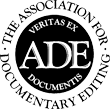Extracts from The Young Idea
2016 Preface
Extracts from The Young Idea
Handwritten shipboard newspapers are not often mentioned in discussions about
Victorian periodical culture. I found Bampfield's extracts from The Young Idea while conducting dissertation research at
the National Maritime Museum in Greenwich and later discovered McArthur's
lithograph edition of the full run at the British Library. As I learned more
about these exciting artifacts, I decided I had to find a way to make them
accessible to more people and encourage scholarly conversation. I am grateful to
the many scholars who have helped me to make this edition a reality, beginning
with Dino Felluga, who encouraged me to speak with the project manager at NINES
(Networked Infrastructure for Nineteenth-Century Electronic Scholarship) when he
learned about my project. My plan was to create a simple website to share my
transcriptions from The Young Idea, but Dana Wheeles
very wisely encouraged me to learn more about the Text Encoding Initiative (TEI)
before proceeding.
I got my first introduction to the TEI from a presentation by Laura Mandell
during the 2013 meeting of the Melville Electronic Library Project (MELCamp). I
began this edition in earnest under the guidance of Beth Luey, Mary-Jo Kline,
and Daniel Feller during the 2013 Institute for Editing Historical Documents. I
am tremendously grateful to the Association for Documentary Editing for funding
that early training. I continued my training under the inimitable Julia Flanders
during a seminar on "Advanced TEI Concepts" at the 2014 Digital Humanities
Summer Institute (DHSI). This seminar helped me refine my approach to this
edition and provided a more thorough understanding of the Text Encoding
Initiative. I am grateful to DHSI for a tuition scholarship to participate in
the seminar and Interdisciplinary Performance Studies at Yale (IPSY) for funding
my travel to Victoria BC; I thank Joseph Roach especially for his enthusiastic
support of this project
I am incredibly grateful to my two coeditors on this project, Teresa Navarro and
Katelyn Sahagian, students at the University of New Haven who brought energy and
enthusiasm to the tasks of transcription and proofreading in the summer of 2015.
I was able to collaborate with these two students through the support of the
University of New Haven's Summer Undergraduate Research Fellowship (SURF)
program. After years researching this little-known material on my own, I was
thrilled to hear their commentary on Reverend Bampfield's atrocious handwriting
and the contributors' fascination with puns. It has also been gratifying to be
able to show them how the work they put into transcribing and encoding has made
this digital edition possible.
The permissions costs associated with publishing archival images online remains
one of the most significant barriers to the creation of open-access digital
editions. I am grateful, therefore, to Joseph Roach and the Andrew W. Mellon
Foundation for enabling me to purchase a rare copy of McArthur's lithograph
edition so I can reproduce images here free of charge. I am also grateful to
Nova Jones (a descendant of Robert Dexter, who served aboard HMS Chesapeake) for alerting me to this edition after
reading about this project online. Images of Bampfield's extracts from The Young Idea are reproduced in this edition with the
generous permission of the National Maritime Museum at Greenwich.
I would like especially to thank Amanda Gailey, Andrew Jewell, and the staff of
Scholarly Editing for their guidance and careful
attention as I worked on this project over several years. Their assistance in
developing this interface not only makes the seven issues of this edition
possible, but also provides a model for the publication of future issues. I
liken the expertise of the team at Scholarly Editing to
the talent of Paul Jerrard, the lithographer whose craft made it possible for A.
D. McArthur to share his handwritten newspaper with the public in 1867. Our
publication technologies have changed dramatically, and I am grateful to have
been taught how to publish data in a format that can accommodate technological
advances we have not yet imagined.

